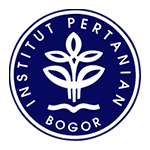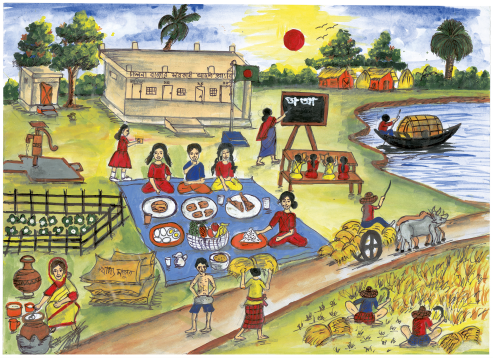 Anika Islam, 9, from Bangladesh was among the 120 finalists of the WFP Children’s Design Competition 2017, which was open to all children who benefit from school meals programmes involving WFP.
Anika Islam, 9, from Bangladesh was among the 120 finalists of the WFP Children’s Design Competition 2017, which was open to all children who benefit from school meals programmes involving WFP.
What does Zero Hunger mean to you? Children who receive school meals from the World Food Programme (WFP) in 22 countries answered this question through the drawings they submitted as part of the WFP Children’s Design Competition 2017. Twenty of them will receive cash prizes for themselves and their schools.
Every day, millions of children around the globe turn up for school on an empty stomach. This affects their ability to learn, pursue their aspirations and fulfil their potential.
To help children concentrate on their lessons rather than on the rumblings in their tummies, WFP is running school meals programmes in over 60 countries and providing advice to government-led schemes in another 10.
For 13-year-old Sohaimen, from the Philippines, there is a clear link between having access to nutritious food and being able to pursue one’s dreams. In his drawing, children dressed in the distinctive garb of different professions sit around a table laden with healthy food.
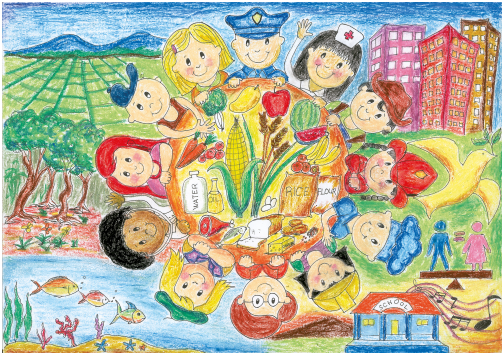 Sohaimen M. Birol, a 13-year-old boy from the Philippines thinks nutritious food should be on every family’s table, so that children can achieve their career dreams.
Sohaimen M. Birol, a 13-year-old boy from the Philippines thinks nutritious food should be on every family’s table, so that children can achieve their career dreams.
“If there was no hunger, all children would go to school and there would be equality between men and women,” he says.
Soniya, a 10-year-old from Nepal who wants to be a doctor one day, could not agree more.
“A girl without food cannot study as she is always hungry and can only think about what she will eat next,” Soniya says. She is happy when she eats at school as she feels she can learn better.
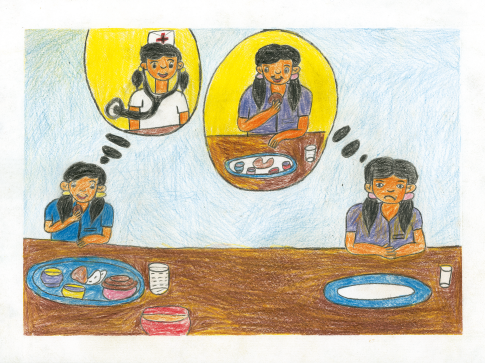 As her drawing shows, Soniya Shrestha, 11, from Nepal, wants to study to become a doctor.
As her drawing shows, Soniya Shrestha, 11, from Nepal, wants to study to become a doctor.
Soniya and Sohaimen’s drawings were among thousands of artworks that came in from participating schools. WFP country offices conducted a preliminary screening that led to the choice of 120 finalists.
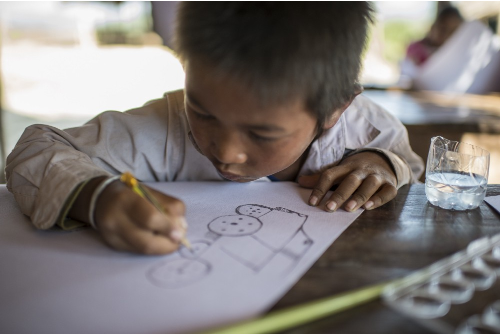 Thousands of artworks came in and were selected by WFP country offices. Photo: WFP/Rein Skullerud
Thousands of artworks came in and were selected by WFP country offices. Photo: WFP/Rein Skullerud
 Left to right: children at work in India (Photo: WFP/Photolibrary), the Philippines (Photo: WFP/Photolibrary) and Jordan (Photo: WFP/YoussefZ Zabalawi).
Left to right: children at work in India (Photo: WFP/Photolibrary), the Philippines (Photo: WFP/Photolibrary) and Jordan (Photo: WFP/YoussefZ Zabalawi).
The 20 winning artworks — selected by a jury composed of WFP staff — take us on a journey around the world as seen through the eyes of these young artists: familiar landscapes, everyday scenes at home, at school or in the fields, and even WFP activities.
 Six-year-old Amelí Caballero López, from Cuba, shows WFP food arriving in Baracoa, one of the areas of Guantánamo most affected by Hurricane Matthew in 2016.
Six-year-old Amelí Caballero López, from Cuba, shows WFP food arriving in Baracoa, one of the areas of Guantánamo most affected by Hurricane Matthew in 2016.
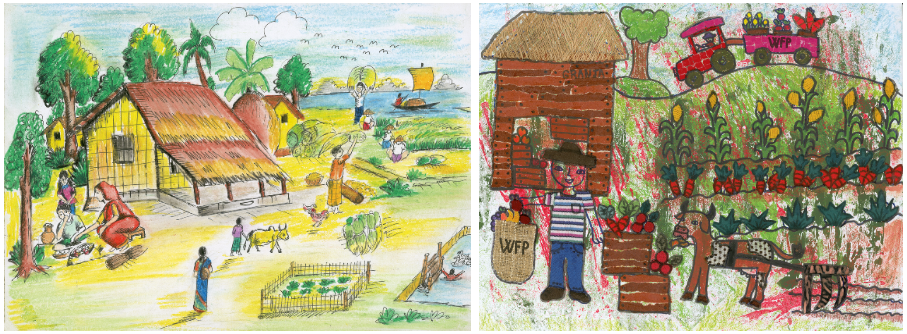 Nooren Faiza Sheha, 10, from Bangladesh and Daniela Díaz Carmona, 10, from Cuba, drew farming scenes from their respective countries.
Nooren Faiza Sheha, 10, from Bangladesh and Daniela Díaz Carmona, 10, from Cuba, drew farming scenes from their respective countries.
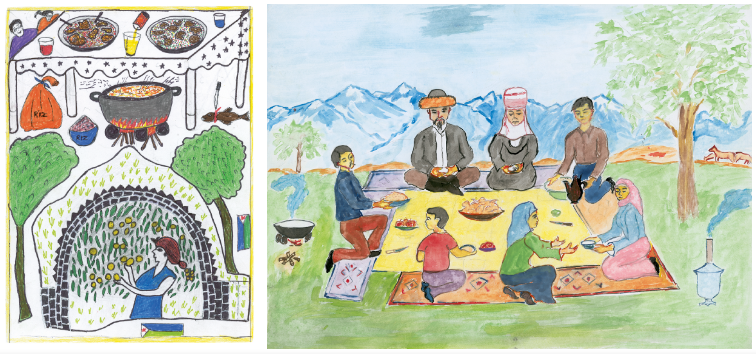 Sharing food with families and friends is important across cultures and continents, as shown in the drawings by Salsabila Ibrahim Mohamoud, 10, from Djibouti (left) and Erkeayim Turganbaeva, 8, from Kyrgyzstan.
Sharing food with families and friends is important across cultures and continents, as shown in the drawings by Salsabila Ibrahim Mohamoud, 10, from Djibouti (left) and Erkeayim Turganbaeva, 8, from Kyrgyzstan.
 The importance of a varied diet is highlighted in artworks by 10-year-old Sradhanjali Sahu from India; Sai Aik Main, 9, from Myanmar; and Ash-Hayanie Gumacap Batingolo, also 9, from the Philippines.
The importance of a varied diet is highlighted in artworks by 10-year-old Sradhanjali Sahu from India; Sai Aik Main, 9, from Myanmar; and Ash-Hayanie Gumacap Batingolo, also 9, from the Philippines.
Through these artworks, we also see what these children dream for the world — not just for themselves. Diego, 10, from Cuba; Vardan, also 10, from Armenia; Christian,13, from the Philippines, and Selvin, 12, from Honduras imagine a future where people come together to share food and achieve Zero Hunger.
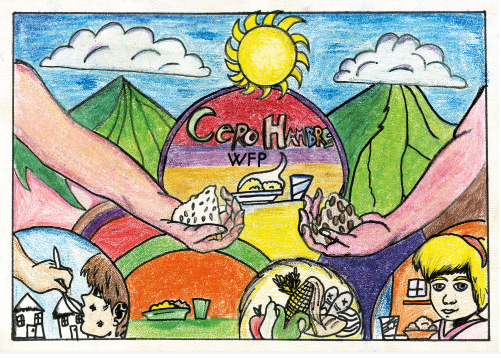 The two hands in this drawing by Honduran Selvin Man Johnson, 12, hold two vital foods which are good for us: rice and beans.
The two hands in this drawing by Honduran Selvin Man Johnson, 12, hold two vital foods which are good for us: rice and beans.
 Coming together to end hunger is a strong theme in the artworks by Vardan Karapetyan, 10, from Armenia; Diego Gejo Céspedes, also 10, from Cuba; and Christian James Pragados Dela Peña, 13, from the Philippines.
Coming together to end hunger is a strong theme in the artworks by Vardan Karapetyan, 10, from Armenia; Diego Gejo Céspedes, also 10, from Cuba; and Christian James Pragados Dela Peña, 13, from the Philippines.
For 12-year-old Amadou, from The Gambia, the world “is better in green”. His drawing shows two alternatives for earth: one that is polluted and affected by climate change and the other that is not polluted and is green, in which people are happier.
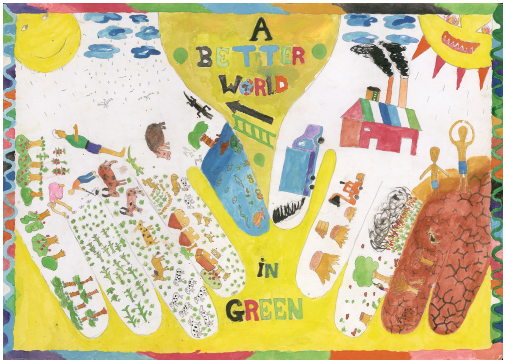 Amadou Wuri Jallow, 12, from The Gambia, wants to become a doctor and hopes for a better world in green, where everyone has enough food.
Amadou Wuri Jallow, 12, from The Gambia, wants to become a doctor and hopes for a better world in green, where everyone has enough food.
Children from war-torn countries depict the everyday situations they are painfully denied — children walking freely to school for Roua, 7, from Syria and learning in an open-air class, boys and girls together, for 11-year-old Mariam (Afghanistan).
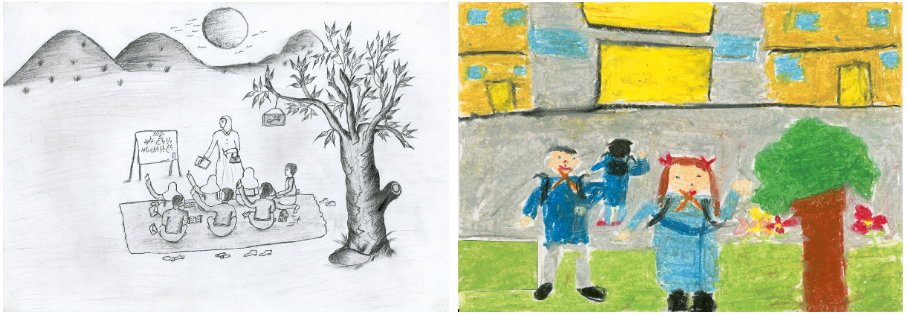 Mariam Ahmadi, 11, from Afghanistan and Roua Mohammad, 7, from Syria share a vision of a peaceful future, where children can live happy, normal lives.
Mariam Ahmadi, 11, from Afghanistan and Roua Mohammad, 7, from Syria share a vision of a peaceful future, where children can live happy, normal lives.
Rather than looking at a brighter future, 12-year-old Areej from Jordan points her finger at what she sees as one of the causes of hunger: the inequality between those that have food, and maybe too much of it, and those who don’t — especially children.
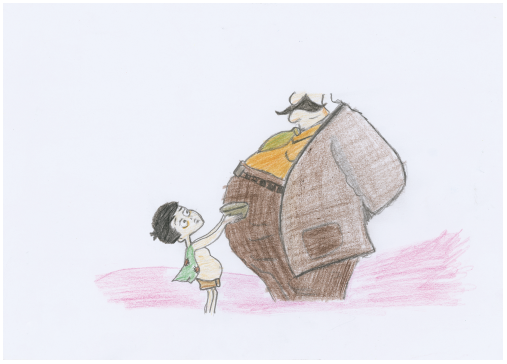 The drawing of Areej Khaled Shdefat, a 12-year-old girl from Jordan, suggests an understanding of the deep inequality that exists in the world.
The drawing of Areej Khaled Shdefat, a 12-year-old girl from Jordan, suggests an understanding of the deep inequality that exists in the world.
The 20 winners will receive a cash prize for themselves and one for their schools, to be spent on stationery.
The artworks will be used as part of WFP’s visual identity at events and on merchandise.
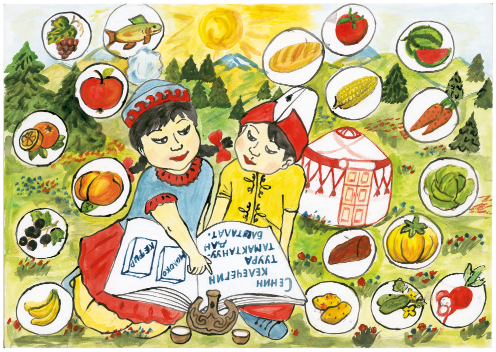 Begimai Ischenbaeva, 10, from Kyrgyzstan, hopes to become a teacher in her own school when she grows up.
Begimai Ischenbaeva, 10, from Kyrgyzstan, hopes to become a teacher in her own school when she grows up.
